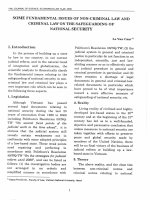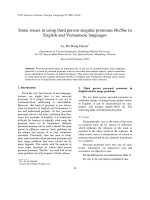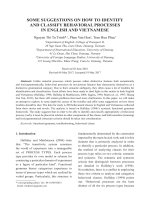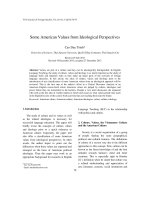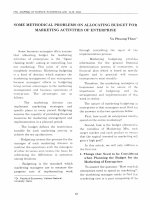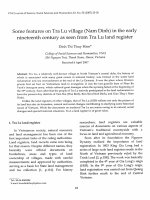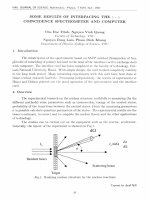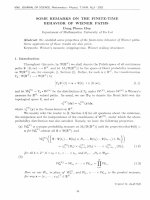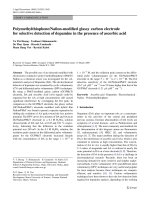DSpace at VNU: Some methodical problems on allocating budget for marketing activities of enterprise
Bạn đang xem bản rút gọn của tài liệu. Xem và tải ngay bản đầy đủ của tài liệu tại đây (4.42 MB, 10 trang )
VNU. JOURNAL OF SCIENCE, ECONOMICS-LAW, N01E, 2004
SOME M ETHODICAL PRO BLEM S ON ALLOCATING BUDGET FO R
MARKETING ACTIVITIES OF E N T E R P R ISE
Vu P h u o n g T h a o ’’
thro ug h controlling the
im plem en tatio n process.
Some b u sin ess m an ag ers often assu m e
th a t allocating budget for m ark e tin g
activities of e n terp rises is the ‘’figure
chewing w o rk ”, aim ing a t controlling, b u t
in pu t
of
the
M ark etin g
bud geting
provides
inform ation for the general financial
d e term in a tio n process of e n terp rises. A
financial plan which is based on specific
figures and is practical will en su re
not m ark etin g. This point of view is
completely erroneous. M arketing budgeting
is a kind of decision which m a tte rs the
m a rk e tin g m a n a g e m e n t of any e n terp rises
because m a n a g e rs ’ efforts in budgeting
bring c e rta in a d v an ta g e s to th e m ark e tin g
m a n a g e m e n t and b u sin ess operations of
en terprises.
The a d v an ta g e s are as
follows:
e n terp rises to exist steadily.
Therefore, th e
businesses need
im portance
of
a rra n g e m e n t and
work in reality.
The
m ark e tin g
division
can
im plem en t
m ark e tin g
s tra teg ies
and
specific p lan s in every period. Budgeting
en sures th e capacity of providing financial
resources for m ark e tin g a rra n g e m e n t and
m a rk e tin g m a n a g e rs of
to be aw are of the
budg etin g
and
the
im p lem en tatio n of this
The n a tu r e of m a rk e tin g b u d g e tin g in
e n terp rises is th a t m a n a g e rs m u st find out
the a n sw e rs to th e two questions below:
First, how much do e n te rp ris e s need to
spend on th e e n tire m arketing?
im p lem en tation in a p la n n ed period.
Second, how is th e bu d get allocated to
th e variables of M ark etin g Mix, each
ta rg e t m a rk e t and each product to ensure
th a t th e capital invested in m a rk e tin g will
- The b u d g e t defines th e restrictions
suitable for each m a rk e tin g activity to
achieve th e set-up objectives.
- B udgeting creates th e prem ise for the
m a n ag e r of each m a rk e tin g division to
combine the operations w ith th e m an ag ers
of o ther divisions and cre ate s th e basis for
a rb itra tin g the differences in operation
among divisions.
gain a high goal?
In this article, we will only a d d re ss to
the first one.
1. T h in gs th at N eed to be C onsidered
w h e n P la n n in g th e B u d g e t for the
M ark etin g o f E n terp rise s
- B ud g eting is the s ta n d a rd which
m a rk e tin g m a n a g e rs use to m easu re the
progress ra te of im p le m e n tin g work
To a n sw e r th e question: ‘’How much do
e n terp rises need to spend on m ark eting ?’,
the m a rk e tin g m a n a g e r needs to find that
m a rk e tin g cost is a p a r t composing of the
n Dr., Faculty of Econom ics, V ietnam National
U niversity, Hanoi.
63
Vu Phuong T h a o
64
cost price of a product. Thus, if th e expense
of m ark etin g is high, th e cost price will be
high and to gether w ith it, th e selling price
will be high. T he high level of selling price
can have im pact on th e selling qu an tity . It
e n te rp ris e s a d m it th a t th e purpose of
m axim izing profits is th e m ain p e rm a n e n t
objective of th e m a rk e tin g decisions of
en terprises, th e y will define the cost level
u n d e r th e w ay to g ain th e m axim um
can curtail the* selling q u a n tity of
enterp rises and th u s, e n te rp ris e s w on’t
probably gain th e g en eral objectives as
well as the m a rk e tin g ones set up in th e
planned period. Therefore, w h en pla n n in g
the budget for m ark etin g , m a n ag e rs
should b e ar in m ind t h a t the more
m ark etin g cost they save, th e better.
profits.
On the o th e r h a n d , m a rk e tin g cost is
the capital inv ested in c re atin g th e
prestige of e n te rp ris e s to th e ir custom ers.
The more prestigious e n te rp ris e s a re in
the
m arket,
th e
more
com petitive
a d v antages th e y have. C re atin g prestige
for custom ers re q u ire s th e e n tire process.
Thus, w hen budgeting, m a n ag e rs of
en terp rises should ta k e th e view of
a p pro priate in v e stm e n t for m a rk e tin g
based on th e ir own financial resources for
creating prestige of th e ir tr a d e m a r k in th e
m arket.
2. T h eoretical B a ses o f B u d g e tin g
2.1. The Theory o f M a x im iz in g P r o fits
All business decisions aim a t gaining
certain purposes. The m ost p o p u lar a n d
p e rm a n e n t purpose p u rs u e d by busin ess
m an agers
is
to
m axim ize
profits.
The model of m axim izing profits is
based on two m ain a ss u m p tio n s below:
+ The income from each u n it of cost
added to m a rk e tin g efforts te n d s to
decrease w h en th e cost level of expenses
continues growing. The deep er the m a rk e t
w as p e n e tra te d , th e more difficult the
chances to gain an ad d ed level of tu rn o v e r
become.
+ To g a m a n ad d ed u n it of m ark etin g
effort, e n te rp ris e s h av e to w aste more
resources becau se effective m eans are
alw ays chosen a t first, less effective m eans
are often u sed afterw ard .
Economic
th eo ries
suggest
th a t
m a n a g e rs
should
con tin ue
to raise
expenses for m a rk e tin g efforts un til the
m arginal income or th e m arginal tu rn o v e r
is still bigger t h a n th e m a rg in a l m ark etin g
cost. M a n a g e rs should only m ain tain
m a rk e tin g e x p e n d itu re at th e level th a t
the m a rg in a l sp en d in g for m arketing
efforts b a lan c e s th e m a rg in a l income or
th e m arg in al tu rn o v e r.
The g ra p h below illu s tra te s this.
If
V NU, Jo urnal o f Science, E conom ic S-Lan . N J E . 2004
Some methodical p roblem s on allocating budget for.
65
T u rn o v e r
M a rk e tin g effort
Effective
m ark etin g
activities
2.2.
The
R e la tio n s h ip
M a r k e tin g E fforts a n d T u rn over
Profits
m axim al
p a th
betw een
W hen
applying
th e
theory
of
m aximizing profits, m a n a g e rs should know
th a t both th e to ta l profits and real
m arginal profits a re s tip u la te d by the level
of turnover. Therefore, it is necessary to
exam ine th e level of tu rn o v e r created from
a certain q u a n tity of cost. T he relationship
of th e level of tu rn o v e r (Q) and m ark etin g
cost (C) is called T u rn o v e r Satisfying
Function.
The
re la tio n sh ip s
of
satisfying
tu rn o v e r
a re
ex am in ed
w ith
two
assum ptions.
- First, th e m a rk e t is basically stable in
te rm s of size a n d competition.
- Second, th e re a re no changes in
m ark etin g s tra te g ie s d u rin g th e tim e we
survey.
VNU. Journal o f Science, E conom ic S-Law, N„IE, 2004
'Ineffective
m a rk e tin g
activities
T here a re four p rim a ry
tu rn o v e r satisfying function.
models
of
+ The F irst M odel
The re latio nship betw een tu rn o v e r and
m a rk e tin g effort is linear. The increase in
m a rk e tin g effort will add to the turnover
a n d profit. Given th a t if en terp rises w an t
to increase the tu rn o v e r a n d profit, they
have to try to raise th e m a rk e tin g budget
to the m axim al level. The m ark etin g cost
is th e capital t h a t e n te rp ris e s invest for
th e ir prestige. The hig h er the prestige is,
th e more possible it is to create a greater
sale volume.
Therefore, in th e ir certain financial
circum stances, e n te rp ris e s should spend
on m a rk e tin g as m uch as possible.
+ The Second M odel
W hen th e level of tu rn o v e r is directly
proportional to the level of m ark etin g cost,
b u t the total of cost h a s to reach a certain
Vu Phuong Thao
66____________ —
-- ------------------------------------------------------------------------------------------------------------------------------------------------------------------------------------------------------
Second, th e grow ing m ark etin g cost
will re s u lt in the in c re ase in the selling
price. In its tu rn , th e increase in the
selling price will raise th e sale quantity.
This case is called g ra d u a lly decreasing
effect. This tu rn o v e r satisfying function
mĩm m vun level* it will in c re a s e the
ÍU t‘ h a t th e tu r n o v e r a n d rprofit
turnover", Ỉ.n
.y
e 1 'his case is called th re sh o ld
will rise
T
This t u r n o v e r sa tisfy in g function
eitcct. i 11
th a t e n te r p r is e s sh o u ld n o t spend
l t t l e o*1 m a r k e tin g b e c a u se th e cost
, I
<rư> low d o e sn ’t c re a te m otivation
which IS
_0cr: t h e tu r n o v e r as well as
to increase
f
shows t h a t if th e tu rn o v e r w a n ts to be
effective in using in v e s tm e n t capital for
m arketing, e n te rp ris e s ne ed to define the
restriction of m a rk e tin g cost.
rises doesn t s p e n d a n y m oney on
marketing-
+ The Fourth M odel
+ T h e T'u r d M o d e l
This is th e com bination of the two
cases above. The “S” sh a p e d curve of the
tu rn o v e r satisfying function shows th a t
The l e ^ ° f tu r n o v e r is inversely
proportionaal :o t h e level of m a rk e tin g cost,
each level of a d d itio n a l effort
In this c&s*.
ill create jr.e level of g ra d u a lly satisfying
turnover vt first, w h e n in c re a s in g the
1
cost, th e t u r n o v e r will get the
marketing
” k
the tu rn o v e r level d ep en d s on how the
m a rk e t satisfies th e different levels of
m arketing. T he re la tio n sh ip betw een the
tu rn o v e r an d m a rk e tin g effort is not
always linear. W hen budgeting, m anag ers
need to consider th e fe a tu re s of the ta rg e t
m ark et, which re g u la te th e size an d the
features of th e m a rk e t d em an d , in other
words, th e satisfaction of the ta rg e t
m a rk e t to m a rk e tin g effort.
real m arginal one or will n o t cre ate
aỊ marginal tu r n o v e r b e ca u se of the
’
fcllovriag reasons:
p
the m a rk e t is re g u la rly lim ited
.
if size. T h e c o n s u m e rs a t a
in tern*
line
certair. U
I* will re a c h th e s a tu r a ti o n of
^vorUfts. In s te a d of in c re a s in g the
usiĩự pr-H
turnover fCBle, th e a d d itio n a l m a rk e tin g
cr oai1 ia'e an inverse effect,
effort
A
3
/
Q
T u rn ov er satisfying functions
described on th e g ra p h s below:
are
Q Ỹ
j
Q
/
/
N.
/
/
/
/
-----
Model 2
w
w
Q
Model 3
c
Model 4
VNU. Journal o f Science, E conom ics-Law . N„1E, 2004
Some m ethodical problem s on allocating budget for...
—
3. T ec h n iq u es o f M ark etin g B u d g etin g
in E n terp rise s
For m an ag ers, th e application of the
theories m entioned above in order to make
a decision on b u d g e t in reality is very h ard
because of th e following reasons:
- First, m a n a g e rs have too little or do
not have a n y d a ta to m easu re the
relationships betw een m a rk e tin g expense
and tu rn o v e r satisfaction. In addition, the
re q u ire m e n ts for tim e a n d necessary cost
for collecting a n d processing these d a ta to
get essential inform ation m ake en terp rises
hesitate to m e asu re these relationships.
- Second, th e re latio n ships of tu rnover
satisfaction m entioned above are based on
certain
suppositions.
In
fact,
these
suppositions are difficult to be accepted
because b usiness e n v iro n m e n t alw ays has
changes, b u t it is not alw ays stable ideally.
- Thus, in reality some techniques are
used to define th e cost for th e M arketing
Program m e of en terprises.
The te ch niq ues are as follows:
3.1. The P re v io u sly S im ila r M ethod
The
method
planned
activity
planned
n a tu re of th e previously similar
is the m a rk e tin g bu dget in the
period, based on th e cost for this
in th e previous year. If in the
y e ar th e re a r e n ’t any big changes
in business operations, the budget level
will be considered as m uch as the fact of
th e previous year. M an a g e rs can adjust
th e budget level in th e p lan ned year to
special situations. For example, in the
planned year, an e n te rp rise developed an
additional new product. If th e m arketing
budget last y e ar is 600 million VND, the
VNU, Journal o f Science, Economic S-Law', N,)IE, 2004
—
-----------------
67
m a rk e tin g b u d g e t th is y e a r is als( 60
million VND. W hen th e enteirLrjQ, >
1
to intro du ce a new product i n thí _ 1
a(! n n rk e t
in th e p la n n e d y e a r a n d estirmatfcc fiu
~
the
m a rk e tin g cost tor th is product c 20
million VND, th e m a r k e tin g bacaof
r
® H th e
p la n n ed y e a r will be 800 million V\J EYROn
million VND + 200 million 7Ịjj) _
million VND).
T he a d v a n ta g e of th is method 1-,
1
^ sinpie
a n d easy to be applied. T he planned f
of th e b u d g e t is reliable W a j s
b u d g et level is b ased on the
J
experience of th e previous y e a r
This
m eth o d
has
disacv-^ 4.
v*nt;ges.
B u dgeting based on th e thoroigjj je ,
J
into th e re la tio n s h ip betw een rv>o4.
cost and
profit can lead to th e ineffeitVfcne
f
in v e stm e n t c a p ita l in m a r k e t nr o th
o th e r h a n d , th e b u sin ess enviDrvnent th
d e m an d of c u sto m ers and fOnj.etii
changes, if th e e n te rp ris e still a>p ^es k
m ethod, it can m iss valuable 0)P)rUnv
b ro u g h t ab o u t by th e se changes Dĩ ịị
not realize
modified.
to
ineffectivemsi
to b
D ue to th e se disadvartare? th
previously sim ilar method is Oil iuit'bl
w hen th e e n te r p ris e operates iị x
t
stable condition a n d the eU(rpriS(
satisfied w ith th e gained levelso t\rnc
a n d profit w ith o u t w antin g to rroDve h
b u sin ess goals.
3.2. The P ercentage-of- S a e dithoi
T his m eth o d is th e improvcm n of h
previously s im ila r method. It s )£sed
th e
ra tio
relatio n sh ip b e w e \ h
m a rk e tin g cost and turno'e] 0f
e n te rp ris e in th e past. This fc h» m, t
p o p u la r m ethod.
)
Vu Phuong T h ao
68
According to th is method, to d eterm ine
the budget for m a rk e tin g in th e plann ed
period, m a n ag e rs m u s t have predictive
figures on th e tu rn o v e r in the planned
year an d the percentage of th e m ark etin g
cost in com parison w ith th e tu rn o v ers of
the previous years.
This m ethod h a s th e m ain ad v an tag es
as follows:
- It is simple a n d easy to be applied.
- It concerns a b o u t th e changes in
business e n v iro n m e n t as well as turn o ver
levels. If the tu rn o v e r in th e planned y ear
is higher th a n th e re p o rte d one in th e
im plem entation
year,
the
m a rk e tin g
budget in th e p la n n ed y ear will grow
com pared w ith th a t in th e im plem en tatio n
year and vice versa.
- It allows e n te rp ris e s to control the
cost and e n su re s t h a t th is cost will be
compensated.
The d isad v a n ta g es of th is method are
th a t it is u n sy ste m a tic an d it doesn’t
reflect the cause a n d effect relationship
betw een m a rk e tin g a n d tu rnover. Beside,
this m ethod m akes u s confuse th a t th e
tu rn o v e r affect th e m a rk e tin g cost while,
in fact, the m a rk e tin g cost h a s decisive
influence on the turnover*.
This m ethod should be applied w hen
the tu rn o v e r of a n e n te rp ris e doesn’t
depend too m uch on th e level of m ark etin g
effort.
3.3. The V iable M eth o d
U nlike th e two m ethods above, the
method of m axim al possibility does not
depend on experience a n d the relationship
betw een tu rn o v e r a n d m a rk e tin g cost in
th e past, b u t it relies on the c u rre n t
finance of a n e n te rp ris e .
This m eth od is b a se d on th e viewpoint
th a t m a rk e tin g cost is no t the cost to
create th e f u tu r e tu rno v er, but is an
in v e stm en t in th e tu rn o v e r a n d prestige of
a product b ra n d or the prestige of an
en terp rise in th e fu tu re. T hu s, in fact, a t a
certain time, th e e n te rp ris e can reduce or
reject th is cost to overcome financial
difficulties in a sh o rt-term . When the
a d v an ta g e s of th e e n te rp ris e become b e tte r
and thu s, th e fin ancial resources of the
en terp rise gets b e tte r, it will spend on
m arketing.
According to th is method, the budget
for m a rk e tin g d e p e n d s on th e e n te rp ris e ’s
financial reso u rces a fte r e n su rin g some
certain profits.
W hen
applying this
method, th e e n te r p ris e can en sure the
m inim al level of profit to exist and
develop. On th e o th e r h a n d , a t a certain
level, the m a rk e tin g cost really creates the
fu tu re ’s value.
This can allow an
e n terp rise o p e ra tin g in a quite stable
e n v iro n m e n t to decrease th e m arketing
cost in a s h o rt te r m w ith o u t dam aging its
position in th e m a rk e t. It is necessary to
know th a t th e in v e s tm e n t in m ark etin g
before w as e n o u g h to c re a te a re s u lt of
tu rn o v e r as expected. T h is is the m ain
ad v a n ta g e of th is method.
However, th is m ethod
d isad v a n ta g es a s follows:
-
has
some
T he a p plicatio n of th is method does
not re q u ire th e profound knowledge of the
m a rk e tin g influence on turnover and
profit. T he b u d g e t is ind ependently built
from w h a t th e m a rk e tin g can create, so it
VNU, Journal o f Science, Economic S-Law, N J E , 2004
Some m ethodical pro b lem s on allocating budget for.
may re s u lt in a s itu a tio n in which the
en terp rise will spend m ore th a n needed
level or does not spen d enough to take
adv antag e of th e a ttra c tiv e opportunities
which m ay em erg e in th e m a rk e t in the
planned period.
- M a rk e tin g cost c h ang es, depending
on fiscal years. If in a n y financial years,
th ere is much, m uch is spent. If in an y
fiscal year, th e re is little, little is spent. Or
if in an y financial years, th e re are a lot of
difficulties, n o th in g is spent. Therefore,
the long te rm m a rk e tin g stra te g ie s of the
en terp rise are h a rd to g a in the re su lts as
expected.
3.4.
The M e th o d o f P l a n n in g B u d get
B a se d on C o m p e tito r s 9 M a r k e tin g Cost
Level
This m ethod is b ased on the view th a t
considers m a rk e tin g a s a competitive
weapon w hich can h e lp an en terprise
improve its com petition position in the
m arket. According to th is method, the
en terp rise will sp end m ore th a n the cost
level of th e co m petitors if it w a n ts to
overwhelm th e com petitors. The enterp rise
can spend on its m a rk e tin g less th a n the
cost levels of th e co m petito rs if it believes
th a t it will use th e cost m ore effectively.
The p rim a ry stro n g point of this
method is th a t it is sim ple to calculate and
possible to set b u sin ess m a n a g e rs ’ mind a t
rest.
This m e th o d h a s som e draw backs as
follows:
- The im p le m e n ta tio n of th is method
requires e n te rp ris e s to have in h a n d
sufficient, accurate, and timely information
VNƯ, Journal o f Science, E conom ic S-L uw, N„l E, 2004
69
about the com petitors and th e ir m arketing
operations. It is to im p le m e n t this or it is
possible to im p le m e n t th is with a high cost
to collect information.
- U sing th is m ethod can speed up
competition am ong th e en terp rises in th e
sam e good b ra n c h to th e extreme, which
m akes all th e m em bers in th e good branch
incur damage. In such a situation, any
en terp rises which are th e strongest will
win if they still continue staying in the
branch.
- This m ethod is based on the
a ssu m p tio n
th a t
th e
budgeting
of
com petitors is th e scientific and logical
basis. In fact, if th e com petitors’ budgets
a re not sp en t system atically and they do
not exam ine rightly th e conditions of
b usin ess environm ent, th e enterprises will
follow “this broken w heel tra c k .”
- It is difficult to gain certain
g u a ra n te e because th e m a rk e tin g targets,
m a rk e tin g resources, an d opportunities of
e n terp rises m ight not be sim ilar to
com petitors’. Therefore, it is impossible for
e n terp rises to spend on th e ir m ark eting
operations, which is b ased on com petitors’
experience.
3.5.
M eth o d
The O b jective a n d Task ba sed
According to this method, to determ ine
th e m ark etin g budget, m a n ag e rs need to
set up specific ta rg e ts of m arketing
o peration in th e p la n n ed period. After
defining th e targ ets, m a rk e tin g m anagers
n eed to plan an y work which is necessary
to im p lem ent in o rd e r to achieve the set-up
ta rg e ts a n d th e cost for im plem enting each
work. The m a rk e tin g b u dg et level will be
70
Vu Phuong T h a o
determ ined on the basis of cost to
im plem ent th e e n tire work. Moreover, a
m easure system will control the progress
ra te in carrying out th e se targets.
This
method
advantages:
has
th e
following
- It req uires m a rk e tin g m a n ag e rs to
p resent in detail e n te rp ris e ’s ta rg e ts of
m a rk eting operation. T hus, 'h e e n terp rises
will have clearer pictures of th e ta rg e ts
th a t need reaching a t as well as th e work
th a t needs doing. The clear and specifi
u n d e rs ta n d in g about th e work will be the
good directions for m a rk e tin g divisions to
im plem ent th e ir plans well and combine
actions with others.
- It requ ires settin g up a n information
system to m easu re th e progress ra te of
im plem enting th e ta rg e ts a n d plans
accurately and appropriately.
- It provides m a n a g e rs with useful
feedback to b e tte r th e budg etin g process
and set up the work ta rg e ts or plans.
- This is th e m ethod a ttra c tiv e to the
en terprises w here th e sh ort-term goals
play an im p o rta n t role or in case the
e n terp rises’ m a rk e tin g influences on the
goals of business operation s are separated
from th e effects of th e changes of o th er
business en v iro n m en t factors such a s the
economic situation, th e operations of
competitors, and the technological changes.
- W hen applying th is m ethod, the main
obstacle is th a t m a rk e tin g m a n ag e rs m st
u n d e rs ta n d clearly ab o u t ohe relationship
betw een
ta rg e ts
and
correlative
commissions to im p le m e n t the targets. If a
fixed activity is unsuitable for implementii g
the set-up targets, it will not allow the
e n terp rise to gain the ta r g e ts as expected.
To u n d e rs ta n d this re la tio n sh ip clearly,
m a rk e tin g m a n a g e rs should carry out
serious, research effort. T h u s, th is method
should be applied in th e organizations
w ith financial resources.
It is possible to say t h a t except for the
last method, the m ethods m entioned above
have th e following disadvantages:
- The application of these m ethods
helps m an ag ers avoid th e ir responsibilities
for m e asu rin g the rela tio n sh ip s betw een
m ark etin g expense and the goals of
tu rn o v e r and profit im p lem entatio n. This
is th e ir a d v an ta g e a n d d isa d v a n ta g e at the
sam e time. These m eth od s don't give
suggestions to the m a rk e tin g m an ag ers
w hen they wish to im prove the goals of
tu rn o v e r
and
profit
im plem entation.
Moreover, these m ethods do not help the
m a rk e tin g
m a n a g e rs
u n d e rs ta n d
thoroughly and guide th e m in term s of
m a rk e tin g w hen o p e ra tin g in the changing
environm ents.
- M ark etin g bu d g e tin g originates f:om
the satisfaction with th e goals of previous
im plem entation and following th e past
precedents will not give tria ls to m arketing
divisions.
It does
not
req u ire the
m ark e tin g divisions to improve th e ir effort
to contribute to th e success of th eir
e n terp rises
th ro u g h
u n d erstan ding ,
research skills and cre ativ e and h azardous
analyses. Tn stead of b eing offensive and
foreseeing,
these
m ethods are only
defensive and responsive.
W hen using these m eth od s to budget
for the m arketing operations of enterprises,
m a rk e tin g m a n ag e rs should pay attention
to th e following points:
\ ' NU, Journal o f Si e n d '. Economic.\-lxjw . N, JE. 2004
Some methodical problem s on allocating budget for.
First, w hen we use any methods, we
m u st exam ine them . The combination of
methods will be th e basis of planning budget.
Second, b u d g e t is th e figure to quantify
the m a rk e tin g strateg ies. It is not absolute
and constant.
The changes of the
en v iro n m en t c an requ ire e n terp rises to
change the m a rk e tin g s tra te g ie s and the
changes of m a rk e tin g strategies, in tu rn ,
requ ire th e chan ges of b u dg et to en su re
the im p le m e n ta tio n s of th e targets.
Therefore, e n te rp ris e s im plem ent the
m ark etin g p la n s a n d th e b ud get plans,
m anag ers need to exam ine a n d evaluate
the budget level regularly so th a t it is
possible to a d ju s t the b u d g e t level to the
e n v iron m ent a n d the m a rk e tin g strategies.
Third, w h en we use any methods, we
m u st combine th e m to sup po rt and
s tre n g th e n the checking procedures.
Fourth,
th e
detailed
m ark etin g
budgets only m a tte r if they a re relev ant to
the general financial plan. Similarly, the
general m a rk e tin g b ud gets m a tte r when
they are sufficient to implement certain work.
4. B u d g etin g P r o c e d u r e s
To d e term in e th e general m ark eting
b udget of an e n terp rise, th e budget for
each division or each specific operation and
specific work, two methods are usually used:
+ The top-dow n m ethod
The n a tu r e of th is m ethod is th a t the
m arketing m a n a g e rs provide the decision
on the general common b u d g e t size for the
whole e n terp rise, every u n it of the
enterp rise a n d every product channel. The
m an ager of each u n it or each product
c hannel will d is trib u te the received budget
to the divisions or th e operations of their
VNU, Journal o f Science, Econom ic S-L a w , N„IE, 2004
71
own units. If th e m a n a g e rs of the divisions
find th a t such budget cann ot ensure the
achievem ent of th e goals, the senior
m a n ag e r will discuss w ith them to
reallocate th e budget. If the m an agers of
some divisions req uire the increase in the
budget for th e ir own divisions, the senior
m an agers can settle this problem by
raising the total general bu dg et to support
the divisions or reduce the budget of others
w hen it is impossible to increase the total
budget of the whole enterprise.
+ The bottom -up m ethod
The n a tu re of this m ethod is th a t the
m a n ag e rs of divisions them selves define
the operations which m u s t be im plem ented
in the plan ned period to gain the targ ets of
the m a rk e tin g stra te g ie s of th e enterprise.
Then they e stim a te th e cost of these
o p e ra tio n s , s u b m it th e m a s a b u d g e t plan
of the division to the senior m an ager in
charge of th e m a rk e tin g operations of the
enterprise. The senior m a n a g e r examines
these budget p lans a n d if they meet the
req uirem ents, th e y will be considered as
the general m a rk e tin g budget and is
su b m itted to th e director board of the
e n terp rise to incorporate it in the
e n te rp ris e ’s a n n u a l financial plan. If the
a n n u a l financial plan need to be adjusted,
the process will be reversed and the
m a n ag e rs of th e divisions will have to
ad ju st the e stim ate d plan s to the budget
restriction
of
th e ir
divisions.
The
m a n ag e rs of th e divisions balance and
a d ju st the real costs a n d the goal of
im p lem entin g th e inspected budget plan
w hen they are imbalanced.
Each en terp rise m u st depend on its
own real situ a tio n to choose appropriate
methods.
72
Vu Phuong T hao
REFERENCES
1.
Philip Kotler, Quản trị M arketing (Bản dịch tiếng Việt của Vũ Trọng Hùng), NXB Thông kê
Hà, Nội, 1994.
2.
Philip Kotler, Principles o f m arketing, Third edition, Pentice - Hall of India, New Delhi,
1998.
3.
Joseph P. guiltinan and others, M arketing management: Strategy and program s, Sixth
edition, MeGraw- Hill companies, Inc., 1996
4.
Davit w . Cravens, Strategic m arketing, Sixth Edition, MeGraw - Hill companies, 2000
TẠP CHÍ KHOA HỌC ĐHQGHN, KINH TẾ - LUẬT, SỎ' IE , 2004
MỘT SỐ VẤN ĐỂ PHƯƠNG PHÁP LUẬN HOẠCH ĐỊNH NGÂN SÁCH
CHO HOẠT
ĐỘNG
MARKETING CỦA DOANH NGHIỆP
•
•
•
TS Vũ Phương Thảo
Khoa K in h tê, Đại học Quốc g ia H à N ội
Hoạch định ng ân sách cho hoạt động M arkeitng trong tương lai là một trong những
quyết định qu an trọng tro ng q u ản lí m ark eting chiến lược. Vì mục đích đưa ra các phương
pháp hoạch định ng ân sách cho hoạt động m arketing, bài viết này được cấu trúc làm bôn
phần. P h ầ n th ứ n h ấ t tác giả nêu lên một sô' q uan điểm cho rằ n g các n h à q u ả n lí p hải nắm
được để dự toán khi giải quyết các vấn đề liên quan tới hoạch định ng ân sách cho h o ạ t động
m arketing. P h ầ n tiếp theo là hai cơ sở để hoach định n gân sách cho ho ạt động m arketing.
Trong p h ần thứ ba nêu lên n ă m phương pháp hoạch định n g ân sách cho h o ạ t động
m ark eting tổng th ể m à các n h à q u ản lí có th ể sử dụng. Các phương pháp đó là: (1) Phương
pháp giông n h ư lần trưốc; (2) Phương pháp ph ần tră m b án hàng; (3) phương p h áp theo khả
n àn g tôi đa; (4) Phương p háp xác định ngân sách dựa trê n mức chi tiêu cho h o ạ t động
m arketing của đôi th ủ cạn h tra n h ; (5) Phương pháp căn cứ vào mục tiêu và yêu cầu của
hoạt động m arketing. Vì mỗi phương p háp có ưu và nhược điếm cho nên n h à qu ản lí phải
chọn phương pháp p h ù hợp với doanh nghiệp của mình. P h ầ n cuôi đề cập đến th ủ tục hoạch
định ngân sách cho h o ạ t động m arketing.
VNU, Journal o f Science, Econom ics-Law, N 0IE, 2004
